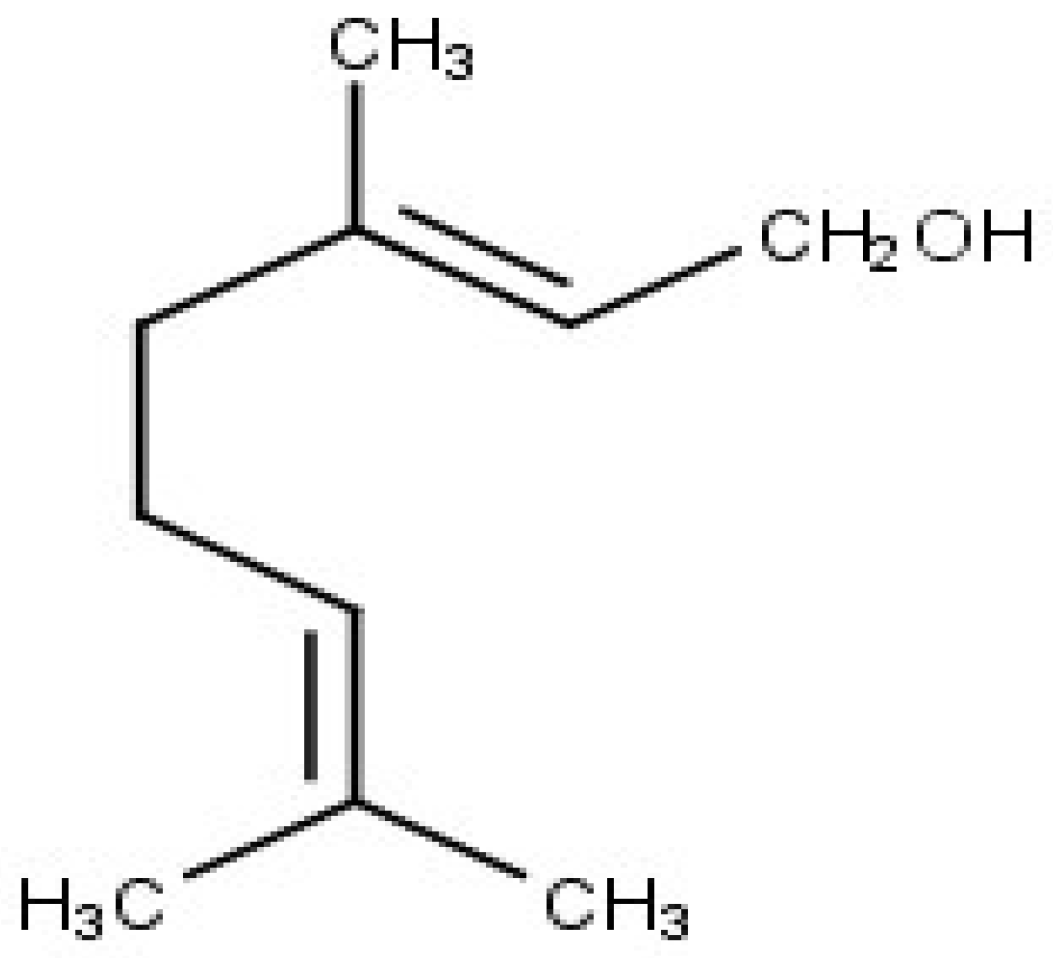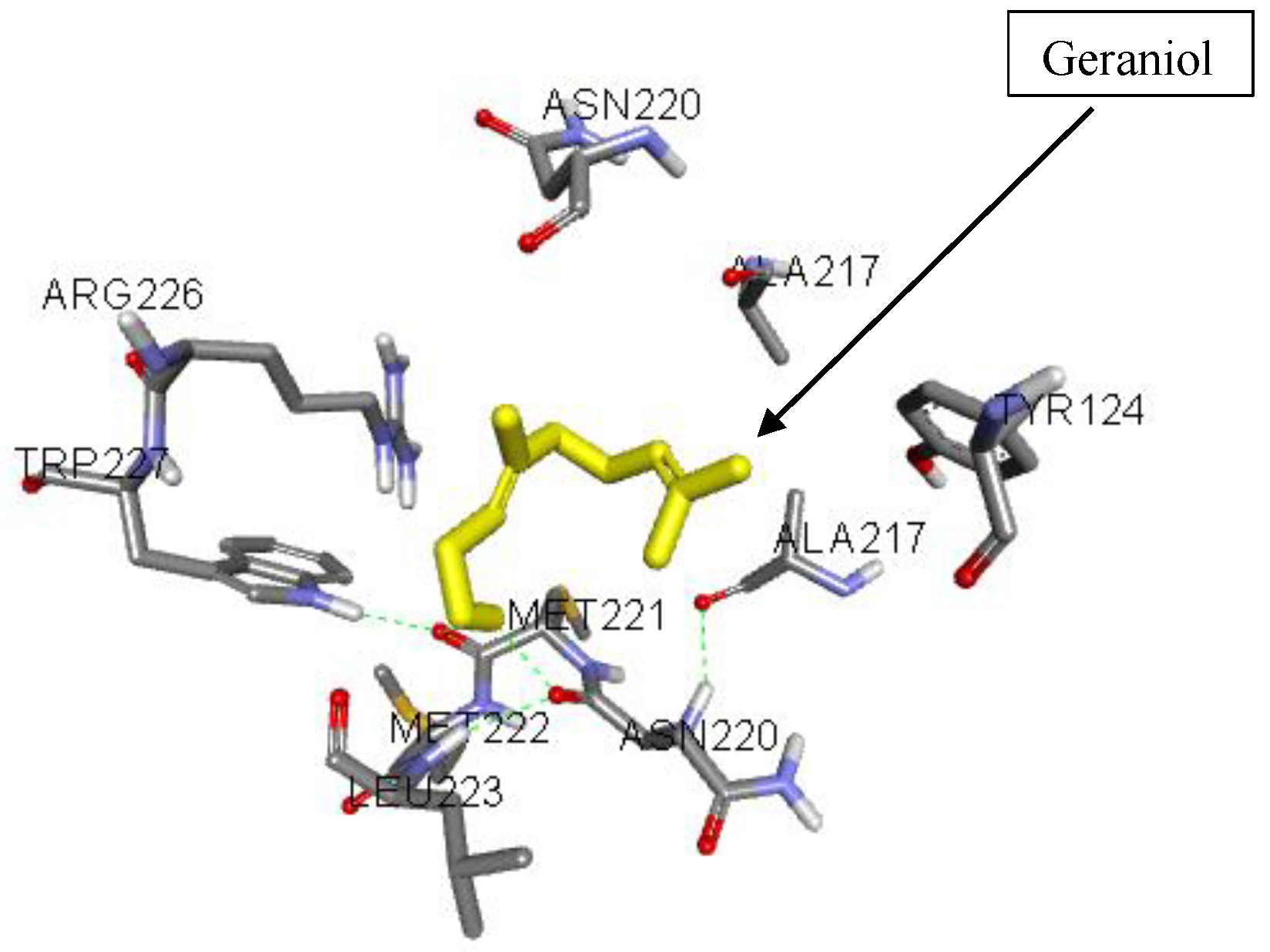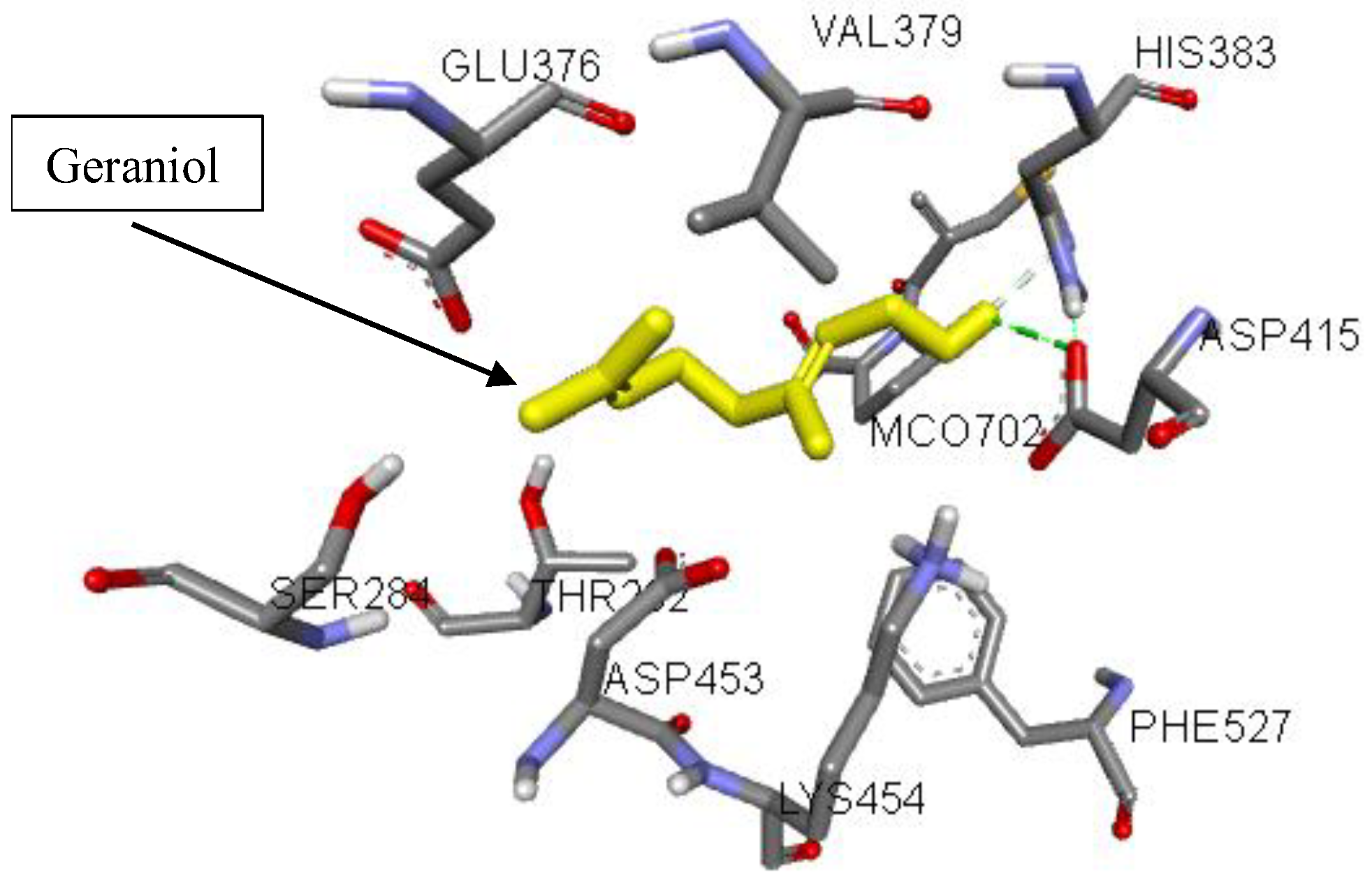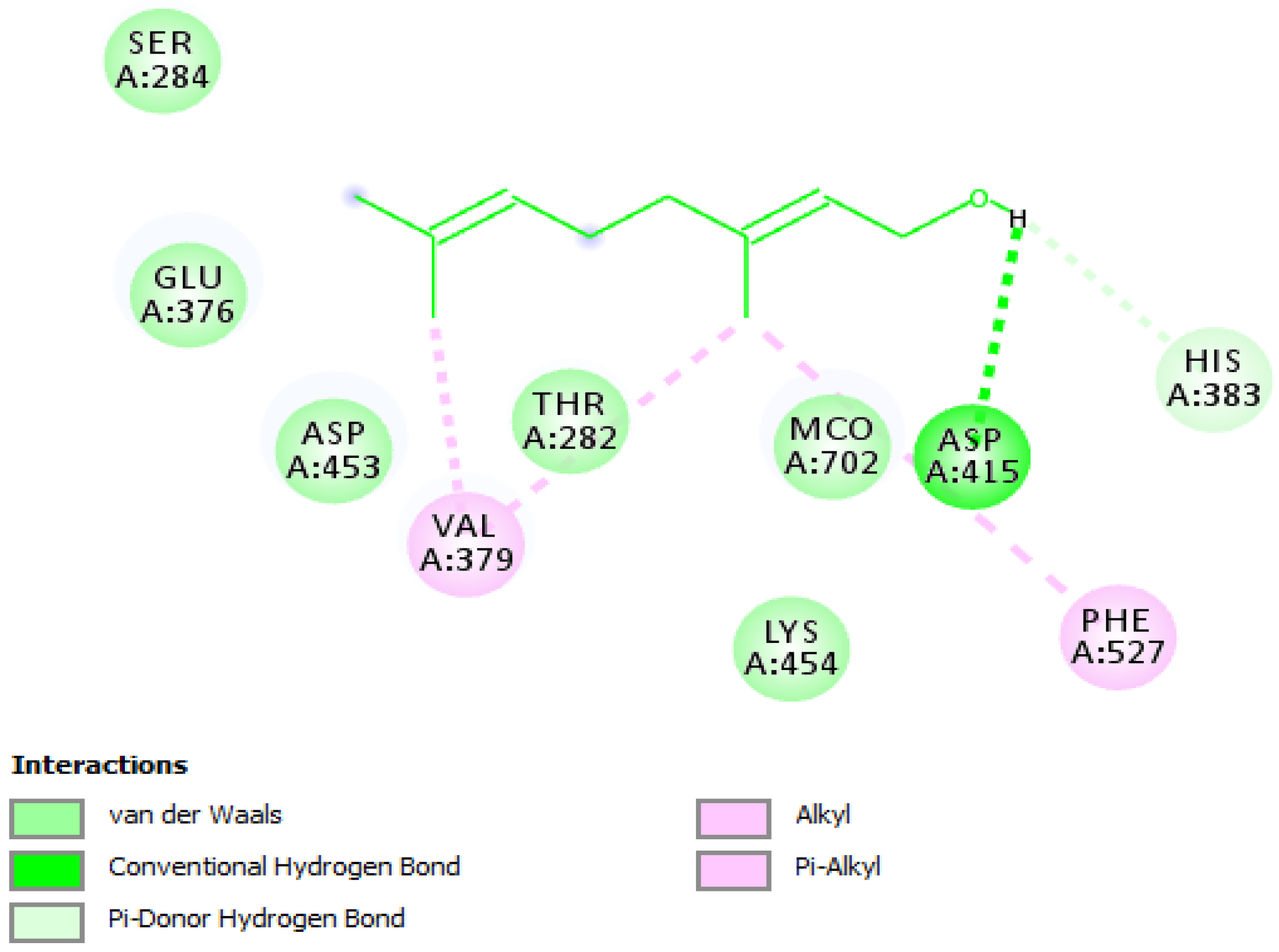In Vitro Study of Multi-Therapeutic Properties of Thymus bovei Benth. Essential Oil and Its Main Component for Promoting Their Use in Clinical Practice
Abstract
:1. Introduction
2. Experimental Section
2.1. Plant Materials
2.1.1. EO Extraction
2.1.2. Phytochemical Profile Analysis of EO by GC and GC-MS
2.2. Quantitative Analyses of Total Bioactive Constituents
2.2.1. Extraction Procedure
Total Phenolic Content (TPC)
Total Flavonoid Content (TFC)
Total Proanthocyanidin Content
2.3. Cytotoxicity Profile against Human Carcinoma Cells
2.3.1. Cell Lines, Medium and Reagents
2.3.2. Cytotoxicity Assay
2.4. Antiviral Activity against HSV-2
2.4.1. Viral Strains, Cell Lines, Medium, and Reagents
2.4.2. Determination of Cytotoxicity
2.4.3. Antiviral Activity Against HSV-2
2.4.4. Molecular Docking Study of Geraniol into the Binding Site of HSV-2 Protease
Protein-Ligand Elaboration and Processing of Docking Analysis
2.5. Anti-Angiotensin-Converting Enzyme (ACE) Activity
2.6. Molecular Docking Study of Geraniol into the Binding Site of ACE
Protein-Ligand Preparation and Processing of Docking Analysis
3. Results and Discussion
3.1. Characterization of EO
3.2. Characterization of Total Bioactive Compounds
3.3. Evaluation of Cytotoxicity Properties
3.4. Antiviral Activities against HSV-2 Replication
3.5. Molecular Interactions of Geraniol with HSV-2 Protease
3.6. Evaluation of Anti-ACE Properties
3.7. Molecular Interactions of Geraniol with ACE
4. Conclusions
Author Contributions
Acknowledgments
Conflicts of Interest
References
- Li, J.W.; Vederas, J.C. Drug discovery and natural products: End of an era or an endless frontier? Science 2009, 325, 161–165. [Google Scholar] [CrossRef] [PubMed]
- McChesney, J.D.; Venkataraman, S.K.; Henri, J.T. Plant natural products: Back to the future or into extinction? Phytochemistry 2007, 68, 2015–2022. [Google Scholar] [CrossRef] [PubMed]
- Jaradat, N.; Adwan, L.; K’aibni, S.; Shraim, N.; Zaid, A.N. Chemical composition, anthelmintic, antibacterial and antioxidant effects of Thymus bovei essential oil. BMC Complement. Altern. Med. 2016, 16. [Google Scholar] [CrossRef] [PubMed]
- Arab Republic of Egypt. Ministry of Health and Population. The English Text of The Egyptian Pharmacopoeia; Central Administration and Pharmaceutical Affairs, Ministry of Health and Population: Cairo, Egypt, 2005.
- Tepe, B.; Sarikurkcu, C.; Berk, S.; Alim, A.; Akpulat, H.A. Chemical composition, radical scavenging and antimicrobial activity of the essential oils of Thymus boveii and Thymus hyemalis. Rec. Nat. Prod. 2011, 5, 208–220. [Google Scholar]
- Abdel-Hady, N.M.; El-Hela, A.A.; Morsy, T.A. Phenolic content of some selected lamiaceous egyptian medicinal plants: Antioxidant potential and ecological friend mosquito-larvicldal. J. Egypt. Soc. Parasitol. 2014, 44, 21–24. [Google Scholar] [CrossRef] [PubMed]
- Nikolic, M.M.; Jovanovic, K.K.; Markovic, T.L.; Markovic, D.L.; Gligorijevic, N.N.; Radulovic, S.S.; Kostic, M.; Glamoclija, J.M.; Sokovic, M.D. Antimicrobial synergism and cytotoxic properties of Citrus limon L., Piper nigrum L. and Melaleuca alternifolia (Maiden and Betche) Cheel essential oils. J. Pharm. Pharmacol. 2017, 69, 1606–1614. [Google Scholar] [CrossRef] [PubMed]
- Tang, J.; Hubbard-Lucey, V.M.; Pearce, L.; O’Donnell-Tormey, J.; Shalabi, A. The global landscape of cancer cell therapy. Nat. Rev. Drug Discov. 2018, 17, 465. [Google Scholar] [CrossRef] [PubMed]
- Greenlee, H. Natural products for cancer prevention. Semin. Oncol. Nurs. 2012, 28, 29–44. [Google Scholar] [CrossRef] [PubMed]
- Kim, C.; Kim, B. Anti-cancer natural products and their bioactive compounds inducing er stress-mediated apoptosis: A review. Nutrients 2018, 10. [Google Scholar] [CrossRef] [PubMed]
- Blowman, K.; Magalhães, M.; Lemos, M.; Cabral, C.; Pires, I. Anticancer properties of essential oils and other natural products. Evid. Based Complement. Altern. Med. 2018, 2018. [Google Scholar] [CrossRef] [PubMed]
- Andrade, M.; Braga, M.; Cesar, P.; Trento, M.; Esposito, M.; Silva, L. Anticancer properties of essential oils: An overview. Curr. Cancer Drug Targets 2018. [Google Scholar] [CrossRef] [PubMed]
- Bayala, B.; Bassole, I.H.; Scifo, R.; Gnoula, C.; Morel, L.; Lobaccaro, J.-M.A.; Simpore, J. Anticancer activity of essential oils and their chemical components-a review. Am. J. Cancer Res. 2014, 4, 591–607. [Google Scholar] [PubMed]
- Lesgards, J.F.; Baldovini, N.; Vidal, N.; Pietri, S. Anticancer activities of essential oils constituents and synergy with conventional therapies: A review. Phytother. Res. 2014, 28, 1423–1446. [Google Scholar] [CrossRef] [PubMed]
- Desai, D.; Bhutkar, M.; Kulkarni, S. Infectivity and growth kinetics of herpes simplex virus type-2 in MOLT4 CCR5+ and CEM CCR5+ T cell lines. Microb. Pathog. 2018, 123, 82–88. [Google Scholar] [CrossRef] [PubMed]
- Troche, G.; Marque Juillet, S.; Burrel, S.; Boutolleau, D.; Bedos, J.P.; Legriel, S. Herpes simplex virus type 2: Cluster of unrelated cases in an intensive care unit. Am. J. Infect. Control 2016, 44, 1178–1180. [Google Scholar] [CrossRef] [PubMed]
- Bittencourt Mde, J.; Freitas, L.K.; Drago, M.G.; Carvalho, A.H.; Nascimento, B.A. Cutaneous neonatal herpes simplex virus infection type 2: A case report. An. Bras. Dermatol. 2016, 91, 216–218. [Google Scholar] [CrossRef] [PubMed]
- Cao, S.; Gan, Y.; Dong, X.; Lu, Z. Herpes simplex virus type 2 and the risk of cervical cancer: A meta-analysis of observational studies. Arch. Gynecol. Obstet. 2014, 290, 1059–1066. [Google Scholar] [CrossRef] [PubMed]
- Hassan, S.T.; Masarčíková, R.; Berchová, K. Bioactive natural products with anti-herpes simplex virus properties. J. Pharm. Pharmacol. 2015, 67, 1325–1336. [Google Scholar] [CrossRef] [PubMed] [Green Version]
- Batty, J.A.; Tang, M.; Hall, M.; Ferrari, R.; Strauss, M.H.; Hall, A.S. Blood pressure reduction and clinical outcomes with angiotensin-converting enzyme inhibitors and angiotensin ii receptor blockers: Protocol for a systematic review and meta-regression analysis. Syst. Rev. 2018, 7, 131. [Google Scholar] [CrossRef] [PubMed]
- Cheng, J.; Zhang, W.; Zhang, X.; Han, F.; Li, X.; He, X.; Li, Q.; Chen, J. Effect of angiotensin-converting enzyme inhibitors and angiotensin ii receptor blockers on all-cause mortality, cardiovascular deaths, and cardiovascular events in patients with diabetes mellitus: A meta-analysis. JAMA Intern. Med. 2014, 174, 773–785. [Google Scholar] [CrossRef] [PubMed]
- Council of Europe. European Pharmacopoeia, 9th ed.; Council of Europe: Strasbourg, France, 2016. [Google Scholar]
- Hassan, S.T.; Švajdlenka, E.; Rengasamy, K.R.; Melichárková, R.; Pandian, S.K. The metabolic profile of essential oils and assessment of anti-urease activity by ESI-mass spectrometry of Salvia officinalis L. S. Afr. J. Bot. 2018. [Google Scholar] [CrossRef]
- Adams, R.P. Identification of Essential Oils by Ion Trap Mass Spectroscopy; Academic press: San Diego, CA, USA, 2012. [Google Scholar]
- McLafferty, F.W. The Wiley/NBS Registry of Mass Spectral Data; Wiley: New Jersey, NJ, USA, 1989. [Google Scholar]
- König, W.; Joulain, D.; Hochmuth, D. Terpenoids and Related Constituents of Essential Oils, Massfinder 3; Convenient and Rapid Analysis of GCMS: Hamburg, Germany, 2004. [Google Scholar]
- Tămaş, M.; Toiu, A.; Oniga, I.; Deliu, C.; Oltean, B.; Coldea, G. Quantitative determination of total polyphenols and flavonoids from indigenous species of epilobium of wild origin and ‘in vitro’ regenerated plantlets. Contrib. Bot. 2009, 44, 119–123. [Google Scholar]
- Hassan, S.T.; Berchová, K.; Majerová, M.; Pokorná, M.; Švajdlenka, E. In vitro synergistic effect of Hibiscus sabdariffa aqueous extract in combination with standard antibiotics against Helicobacter pylori clinical isolates. Pharm. Biol. 2016, 54, 1736–1740. [Google Scholar] [PubMed]
- Bahorun, T.; Aumjaud, E.; Ramphul, H.; Rycha, M.; Luximon-Ramma, A.; Trotin, F.; Aruoma, O.I. Phenolic constituents and antioxidant capacities of Crataegus monogyna (Hawthorn) callus extracts. Mol. Nutr. Food Res. 2003, 47, 191–198. [Google Scholar]
- Supino, R. Mtt assays. In Methods in Moleuclar Biology; Elsevier: New York, NY, USA, 1995; Volume 43, pp. 137–149. [Google Scholar]
- Hassan, S.T.; Švajdlenka, E.; Berchová-Bímová, K. Hibiscus sabdariffa L. and its bioactive constituents exhibit antiviral activity against HSV-2 and anti-enzymatic properties against urease by an ESI-MS based assay. Molecules 2017, 22. [Google Scholar] [CrossRef] [PubMed]
- Hassan, S.T.; Švajdlenka, E. Biological evaluation and molecular docking of protocatechuic acid from Hibiscus sabdariffa L. as a potent urease inhibitor by an ESI-MS based method. Molecules 2017, 22. [Google Scholar] [CrossRef] [PubMed]
- Hassan, S.T.S.; Šudomová, M.; Berchová-Bímová, K.; Gowrishankar, S.; Rengasamy, K.R.R. Antimycobacterial, Enzyme Inhibition, and Molecular Interaction Studies of Psoromic Acid in Mycobacterium tuberculosis: Efficacy and Safety Investigations. J. Clin. Med. 2018, 7. [Google Scholar] [CrossRef] [PubMed]
- Dassault Systèmes BIOVIA. Discovery Studio Modeling Environment, Release 2017; Dassault Systèmes: San Diego, CA, USA, 2017. [Google Scholar]
- Cushman, D.W.; Cheung, H.S. Spectrophotometric assay and properties of the angiotensin-converting enzyme of rabbit lung. Biochem. Pharmacol. 1971, 20, 1637–1648. [Google Scholar] [PubMed]
- Mansour, S.A.; El-Sharkawy, A.Z.; Abdel-Hamid, N.A. Toxicity of essential plant oils, in comparison with conventional insecticides, against the desert locust, Schistocerca gregaria (Forskål). Ind. Crops Prod. 2015, 63, 92–99. [Google Scholar] [CrossRef]
- Aboutabl, E.; Soliman, F.; El-Zalabani, S.; Brunke, E.; El Kersh, T. Essential oils of Thymus bovei Benth. Sci. Pharm. 1986, 54, 43–48. [Google Scholar]
- Noroozisharaf, A.; Kaviani, M. Effect of soil application of humic acid on nutrients uptake, essential oil and chemical compositions of garden thyme (Thymus vulgaris L.) under greenhouse conditions. Physiol. Mol. Biol. Plants 2018, 24, 423–431. [Google Scholar] [CrossRef] [PubMed]
- Delgado-Adámez, J.; Garrido, M.; Bote, M.E.; Fuentes-Pérez, M.C.; Espino, J.; Martín-Vertedor, D. Chemical composition and bioactivity of essential oils from flower and fruit of Thymbra capitata and Thymus species. J. Food Sci. Technol. 2017, 54, 1857–1865. [Google Scholar] [CrossRef] [PubMed]
- Roby, M.H.H.; Sarhan, M.A.; Selim, K.A.-H.; Khalel, K.I. Evaluation of antioxidant activity, total phenols and phenolic compounds in thyme (Thymus vulgaris L.), sage (Salvia officinalis L.), and marjoram (Origanum majorana L.) extracts. Ind. Crops Prod. 2013, 43, 827–831. [Google Scholar] [CrossRef]
- Ali, I.B.E.H.; Bahri, R.; Chaouachi, M.; Boussaïd, M.; Harzallah-Skhiri, F. Phenolic content, antioxidant and allelopathic activities of various extracts of Thymus numidicus Poir. organs. Ind. Crops Prod. 2014, 62, 188–195. [Google Scholar]
- Baharfar, R.; Azimi, R.; Mohseni, M. Antioxidant and antibacterial activity of flavonoid-, polyphenol-and anthocyanin-rich extracts from Thymus kotschyanus boiss & hohen aerial parts. J. Food Sci. Technol. 2015, 52, 6777–6783. [Google Scholar] [PubMed]
- Köksal, E.; Bursal, E.; Gülçin, İ.; Korkmaz, M.; Çağlayan, C.; Gören, A.C.; Alwasel, S.H. Antioxidant activity and polyphenol content of Turkish thyme (Thymus vulgaris) monitored by liquid chromatography and tandem mass spectrometry. Int. J. Food Prop. 2017, 20, 514–525. [Google Scholar] [CrossRef]
- Mata, A.; Proença, C.; Ferreira, A.; Serralheiro, M.; Nogueira, J.; Araújo, M. Antioxidant and antiacetylcholinesterase activities of five plants used as portuguese food spices. Food Chem. 2007, 103, 778–786. [Google Scholar] [CrossRef]
- Taghouti, M.; Martins-Gomes, C.A.; Schäfer, J.; Félix, L.M.; Santos, J.A.; Bunzel, M.; Nunes, F.M.; Silva, A.M. Thymus pulegioides L. as a rich source of antioxidant, anti-proliferative and neuroprotective phenolic compounds. Food Funct. 2018. [Google Scholar] [CrossRef] [PubMed]
- Nickavar, B.; Esbati, N. Evaluation of the antioxidant capacity and phenolic content of three Thymus species. J. Acupunct. Meridian Stud. 2012, 5, 119–125. [Google Scholar] [CrossRef] [PubMed]
- Galasso, S.; Pacifico, S.; Kretschmer, N.; Pan, S.-P.; Marciano, S.; Piccolella, S.; Monaco, P.; Bauer, R. Influence of seasonal variation on Thymus longicaulis C. Presl chemical composition and its antioxidant and anti-inflammatory properties. Phytochemistry 2014, 107, 80–90. [Google Scholar] [CrossRef] [PubMed]
- Jaouadi, R.; Cardoso, S.M.; Silva, A.M.; Yahia, I.B.H.; Boussaid, M.; Zaouali, Y. Variation of phenolic constituents of Tunisian Thymus capitatus (L.) Hoff. et Link. populations. Biochem. Syst. Ecol. 2018, 77, 10–15. [Google Scholar] [CrossRef]
- Tohidi, B.; Rahimmalek, M.; Arzani, A. Essential oil composition, total phenolic, flavonoid contents, and antioxidant activity of Thymus species collected from different regions of Iran. Food Chem. 2017, 220, 153–161. [Google Scholar] [CrossRef] [PubMed]
- Zu, Y.; Yu, H.; Liang, L.; Fu, Y.; Efferth, T.; Liu, X.; Wu, N. Activities of ten essential oils towards Propionibacterium acnes and PC-3, A-549 and MCF-7 cancer cells. Molecules 2010, 15, 3200–3210. [Google Scholar] [CrossRef] [PubMed]
- Ait M’Barek, L.; Ait Mouse, H.; Jaâfari, A.; Aboufatima, R.; Benharref, A.; Kamal, M.; Bénard, J.; El Abbadi, N.; Bensalah, M.; Gamouh, A. Cytotoxic effect of essential oil of thyme (Thymus broussonettii) on the IGR-OV1 tumor cells resistant to chemotherapy. Braz. J. Med. Biol. Res. 2007, 40, 1537–1544. [Google Scholar] [CrossRef] [PubMed]
- Nikolić, M.; Glamočlija, J.; Ferreira, I.C.; Calhelha, R.C.; Fernandes, Â.; Marković, T.; Marković, D.; Giweli, A.; Soković, M. Chemical composition, antimicrobial, antioxidant and antitumor activity of Thymus serpyllum L., Thymus algeriensis Boiss. and reut and Thymus vulgaris L. essential oils. Ind. Crops Prod. 2014, 52, 183–190. [Google Scholar] [CrossRef]
- Kitazato, K.; Wang, Y.; Kobayashi, N. Viral infectious disease and natural products with antiviral activity. Drug Discov. Ther. 2007, 1, 14–22. [Google Scholar] [PubMed]
- Reusser, P. Herpesvirus resistance to antiviral drugs: A review of the mechanisms, clinical importance and therapeutic options. J. Hosp. Infect. 1996, 33, 235–248. [Google Scholar] [CrossRef]
- Piret, J.; Boivin, G. Resistance of herpes simplex viruses to nucleoside analogues: Mechanisms, prevalence, and management. Antimicrob. Agents Chemother. 2011, 55, 459–472. [Google Scholar] [CrossRef] [PubMed]
- Hoog, S.S.; Smith, W.W.; Qiu, X.; Janson, C.A.; Hellmig, B.; McQueney, M.S.; O’Donnell, K.; O’Shannessy, D.; DiLella, A.G.; Debouck, C.; et al. Active site cavity of herpesvirus proteases revealed by the crystal structure of herpes simplex virus protease/inhibitor complex. Biochemistry 1997, 36, 14023–14029. [Google Scholar] [CrossRef] [PubMed]
- Zouari, S.; Zouari, N.; Fakhfakh, N.; Bougatef, A.; Ayadi, M.; Neffati, M. Chemical composition and biological activities of a new essential oil chemotype of Tunisian Artemisia herba alba Asso. J. Med. Plant Res. 2010, 4, 871–880. [Google Scholar]
- Mansour, M.B.; Balti, R.; Rabaoui, L.; Bougatef, A.; Guerfel, M. Chemical composition, angiotensin i-converting enzyme (ACE) inhibitory, antioxidant and antimicrobial activities of the essential oil from south Tunisian Ajuga pseudoiva Rob. Lamiaceae. Process. Biochem. 2013, 48, 723–729. [Google Scholar] [CrossRef]
- Balasuriya, B.N.; Rupasinghe, H.V. Plant flavonoids as angiotensin converting enzyme inhibitors in regulation of hypertension. Funct. Foods Health Dis. 2011, 1, 172–188. [Google Scholar]
- Liu, J.-C.; Hsu, F.-L.; Tsai, J.-C.; Chan, P.; Liu, J.Y.-H.; Thomas, G.N.; Tomlinson, B.; Lo, M.-Y.; Lin, J.-Y. Antihypertensive effects of tannins isolated from traditional chinese herbs as non-specific inhibitors of angiontensin converting enzyme. Life Sci. 2003, 73, 1543–1555. [Google Scholar] [CrossRef]
- Mallikarjun Gouda, K.; Gowda, L.R.; Rao, A.A.; Prakash, V. Angiotensin i-converting enzyme inhibitory peptide derived from glycinin, the 11S globulin of soybean (Glycine max). J. Agric. Food Chem. 2006, 54, 4568–4573. [Google Scholar] [CrossRef] [PubMed]
- Natesh, R.; Schwager, S.L.; Evans, H.R.; Sturrock, E.D.; Acharya, K.R. Structural details on the binding of antihypertensive drugs captopril and enalaprilat to human testicular angiotensin i-converting enzyme. Biochemistry 2004, 43, 8718–8724. [Google Scholar] [CrossRef] [PubMed]





| Identified Compounds | T. Bovei Benth. (%) a | RRI b | Identification Process |
|---|---|---|---|
| α-citral (Trans-citral) | 27.7 | 1140 | tR, MS |
| β-citral (Cis-citral, neral) | 12.4 | 1194 | tR, MS |
| Geraniol (Lemonol) | 32.3 | 1209 | tR, MS |
| dl-camphor | 2.4 | 1430 | tR, MS |
| 3-octanol | 2.2 | 1461 | tR, MS |
| 1,8-cineole (Eucalyptol) | 2.3 | 1531 | tR, MS |
| Thymol | 3.8 | 1578 | tR, MS |
| p-Cymene | 0.1 | 1593 | tR, MS |
| Geranyl isobutyrate | 0.1 | 1681 | tR, MS |
| β-linalool | 1.3 | 1764 | tR, MS |
| Geranyl propionate | 0.2 | 1915 | tR, MS |
| α-cyclocitral | 0.2 | 2028 | tR, MS |
| Linalyl acetate (Bergamol) | 0.2 | 2071 | tR, MS |
| Camphene | 1.8 | 2075 | tR, MS |
| Isocaryophyllene | 1.6 | 2107 | tR, MS |
| Farnesene | 1.7 | 2212 | tR, MS |
| Dihydrocarveol acetate | 0.1 | 2404 | tR, MS |
| β-myrcene | 1.4 | 2621 | tR, MS |
| l-borneol | 0.1 | 2801 | tR, MS |
| β-ocimene | 1.5 | 2839 | tR, MS |
| Nerolidol | 1.1 | 2873 | tR, MS |
| α-limonene | 1.5 | 2903 | tR, MS |
| α-terpinene | 1.2 | 2944 | tR, MS |
| α-phellandrene | 1.4 | 2976 | tR, MS |
| β-pinene | 1.3 | 2995 | tR, MS |
| Total | 99.9 | ||
| Oxygenated monoterpenes | 82.2 | ||
| Monoterpene hydrocarbons | 10.1 | ||
| Sesquiterpene hydrocarbons | 3.3 | ||
| Oxygenated sesquiterpenes | 1.1 | ||
| Others | 3.2 |
| Extract | TPC (mg GAE/g DW of Plant Mterial) | TFC (mg RE/g DW of Plant Material) | Total Proanthocyanidins (µg CC/g DW of Plant Material) |
|---|---|---|---|
| HETB | 85.62 ± 0.82 | 51.23 ± 0.43 | 135.91 ± 0.83 |
| AETB | 74.84 ± 1.43 | 40.51 ± 0.64 | 110.31 ± 1.12 |
| IC50 (µg/mL) | ||||
|---|---|---|---|---|
| Compound | HeLa-R2 | LS-174-D3 | A-549-C5 | >MRC-5 |
| TB-EO | 7.22 ± 1.21 | 9.30 ± 0.84 | 8.62 ± 1.41 | 118.34 ± 0.56 |
| Cisplatin | 4.24 ± 0.81 | 5.21 ± 0.23 | 5.43 ± 0.34 | 10.08 ± 0.71 |
| Test Compounds | CC50 (µg/mL) | EC50 (µg/mL) | SI |
|---|---|---|---|
| TB-EO | >210 | 2.13 ± 0.63 | >98.59 |
| Geraniol | >210 | 1.92 ± 0.84 | >109.38 |
| TB-EO combined with ACV | >210 | 0.81 ± 1.21 | >259.26 |
| ACV | >210 | 1.94 ± 0.41 | >108.25 |
| Compounds | % Inhibition |
|---|---|
| TB-EO | 95.4 ± 0.94 |
| Geraniol | 92.2 ± 1.14 |
| Captopril | 99.8 ± 1.21 |
| Catalyzed reaction (no inhibition) | Nd |
© 2018 by the authors. Licensee MDPI, Basel, Switzerland. This article is an open access article distributed under the terms and conditions of the Creative Commons Attribution (CC BY) license (http://creativecommons.org/licenses/by/4.0/).
Share and Cite
Hassan, S.T.S.; Berchová-Bímová, K.; Šudomová, M.; Malaník, M.; Šmejkal, K.; Rengasamy, K.R.R. In Vitro Study of Multi-Therapeutic Properties of Thymus bovei Benth. Essential Oil and Its Main Component for Promoting Their Use in Clinical Practice. J. Clin. Med. 2018, 7, 283. https://doi.org/10.3390/jcm7090283
Hassan STS, Berchová-Bímová K, Šudomová M, Malaník M, Šmejkal K, Rengasamy KRR. In Vitro Study of Multi-Therapeutic Properties of Thymus bovei Benth. Essential Oil and Its Main Component for Promoting Their Use in Clinical Practice. Journal of Clinical Medicine. 2018; 7(9):283. https://doi.org/10.3390/jcm7090283
Chicago/Turabian StyleHassan, Sherif T. S., Kateřina Berchová-Bímová, Miroslava Šudomová, Milan Malaník, Karel Šmejkal, and Kannan R.R. Rengasamy. 2018. "In Vitro Study of Multi-Therapeutic Properties of Thymus bovei Benth. Essential Oil and Its Main Component for Promoting Their Use in Clinical Practice" Journal of Clinical Medicine 7, no. 9: 283. https://doi.org/10.3390/jcm7090283






